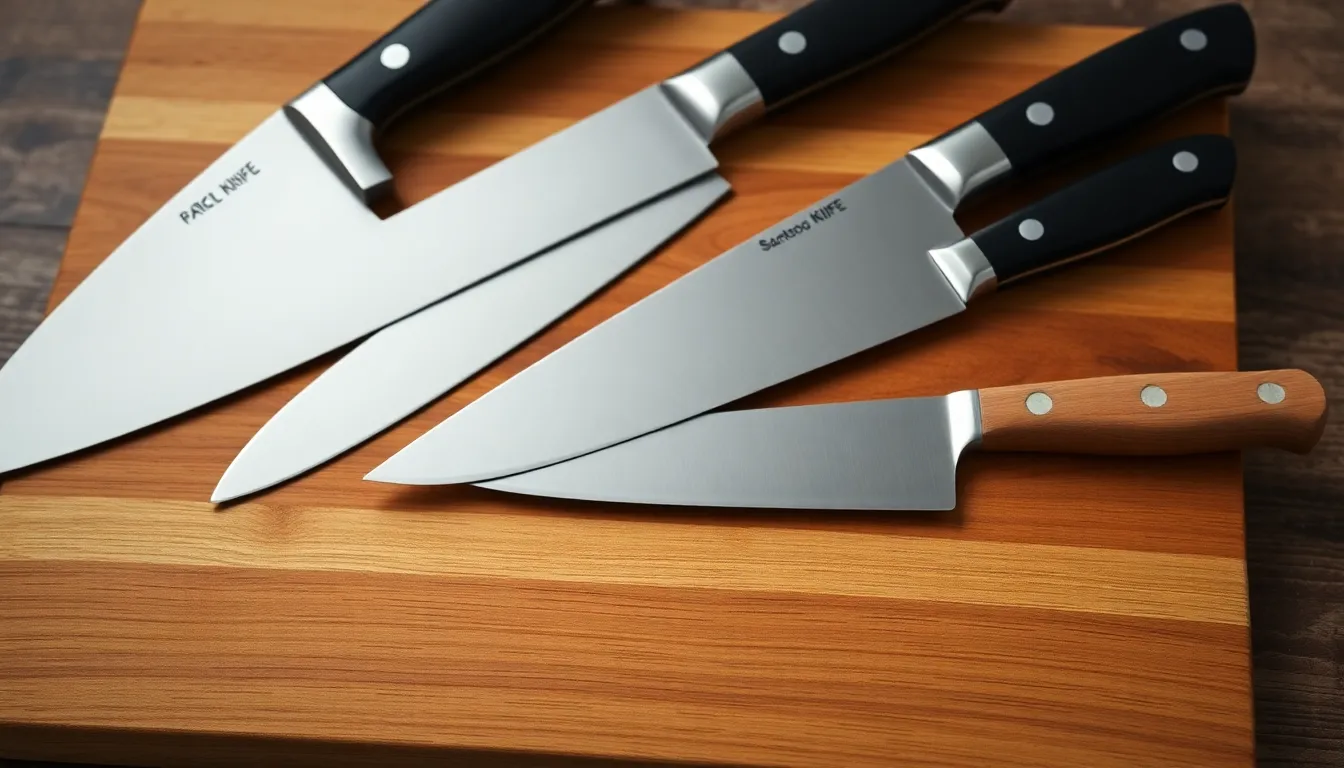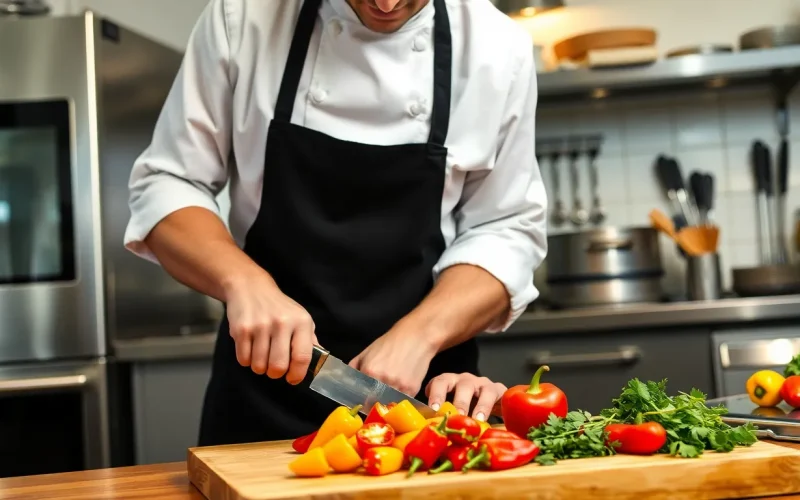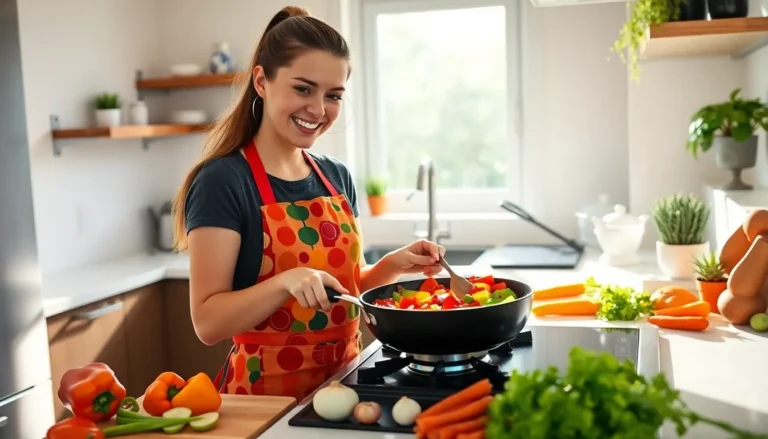Table of Contents
ToggleIn the bustling world of culinary arts, mastering knife techniques is the secret ingredient that can elevate anyone from a home cook to a kitchen ninja. Imagine slicing through vegetables like a samurai, impressing friends and family with your newfound skills. Not only does it make cooking more efficient, but it also transforms the mundane task of chopping into a thrilling experience.
Understanding Knife Techniques
Mastering knife techniques enhances the cooking experience. These skills streamline meal preparation and allow for creativity in the kitchen.
Importance of Knife Techniques in Cooking
Knife techniques provide precision and speed in food preparation. They help minimize waste and enhance presentation. Proficient cooks generate consistent results with uniform cuts, influencing cooking times and flavor release. Learning these techniques also boosts safety, reducing the risk of accidents. Chefs who practice their skills notice improved confidence, creating a more enjoyable cooking atmosphere.
Basic Knife Skills Every Cook Should Know
Every cook benefits from mastering several basic knife skills. Utilizing the proper grip facilitates controlled slicing. Employing the claw grip protects fingers while cutting. Chopping vegetables requires a rocking motion for efficient mincing. Dicing necessitates uniformity, ensuring even cooking. Julienne cuts offer finely sliced pieces, ideal for garnishing or salads. Lastly, understanding how to chiffonade herbs allows for flavorful additions to dishes. These foundational skills form the backbone of effective knife techniques.
Essential Knives for Cooking

Understanding essential knives enhances culinary skills. Each knife serves a specific purpose, contributing to efficient meal preparation.
Different Types of Knives
Chef’s knives excel in versatility, ideal for chopping, slicing, and dicing. Paring knives focus on precision tasks like peeling and trimming fruits or vegetables. Bread knives feature serrated edges designed for cutting through crusts without crushing the soft interior. Santoku knives, originating from Japan, offer a unique blade shape for various cutting techniques. Utility knives bridge the gap between paring and chef’s knives, suited for smaller tasks. Each type fulfills its role, ensuring culinary tasks are completed with ease.
Choosing the Right Knife for Your Cooking Style
Selecting the right knife aligns with personal cooking style and preferences. A chef focused on meal prep benefits from a well-balanced chef’s knife. Those who enjoy baking might prefer a quality bread knife for clean cuts. For intricate work, paring knives offer the control needed for delicate tasks. Evaluating knife weight, handle comfort, and blade material is crucial before making a purchase. By matching knives to cooking habits, efficiency and enjoyment increase.
Mastering Knife Techniques
Mastering knife techniques enhances efficiency and precision in cooking. Key skills like chopping and dicing elevate food preparation.
Chopping and Dicing
Chopping involves cutting food into pieces of varying sizes. Chefs often use a chef’s knife for this process, as it provides versatility. Dicing requires uniform pieces, promoting even cooking. Proper technique includes a claw grip, ensuring fingers are safely tucked away. A consistent size, such as 1/4 inch or 1/2 inch, plays a crucial role in cooking times and presentation. Speed improves with practice, allowing cooks to work quickly and confidently.
Slicing and Julienne
Slicing requires smooth, long cuts, ideal for meats or delicate vegetables. Precision defines the technique, as even slices enhance visual appeal. Julienne creates thin, matchstick-shaped pieces, perfect for stir-fries or garnishes. Using a sharp knife, maintain a straight edge for clean cuts. Techniques like angle positioning help achieve the desired thickness. Cooks can aim for uniformity, supporting even cooking and flavor distribution.
Safety Tips for Using Knives
Knife safety is crucial in any kitchen. Proper techniques can prevent accidents and injuries.
Proper Knife Handling
Grip knives firmly with a secure hand. Use the claw grip to protect fingers while cutting. Position fingers in a curved manner, keeping them away from the blade’s edge. Maintain focus on cutting surfaces and avoid distractions. Always cut away from the body to minimize risk. Place knives on stable surfaces to prevent slipping while not in use. Store knives in designated blocks or sheaths to avoid accidental contact.
Maintaining Knife Sharpness
Sharp knives enhance safety and efficiency. Dull blades require more force, increasing the chances of slipping. Regularly hone knives with a honing steel before use to maintain edge alignment. Additionally, sharpen knives with a whetstone or professional sharpener as needed. Clean knives immediately after use to prevent residue buildup, which can dull blades. Inspect knife edges frequently for signs of wear and address them promptly. Adopting these practices ensures knives perform optimally, contributing to a safer cooking environment.
Mastering knife techniques is essential for anyone looking to enhance their culinary skills. With the right approach to cutting and preparation, cooks can experience a newfound efficiency and creativity in the kitchen. Each knife serves a specific purpose and contributes to the overall cooking process, making it crucial to choose the right tools.
Safety and maintenance are equally important. Proper techniques and regular upkeep ensure knives remain sharp and effective. As cooks practice these skills, they’ll not only improve their cooking but also enjoy the process more. Embracing these knife techniques can transform meal preparation into an enjoyable and rewarding experience.





